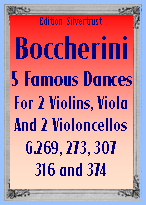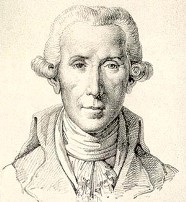Presents
Luigi Boccherini
 |
 |
Minuetto from Op.11 No.3 G.273 Ballo Tedesco from Op.29 No.4, G.316 Larghetto from Op.10 No.5, G.269 |
Five Famous Dances for String Quintet
For 2 Violins, Viola & 2 Cellos
I. Minuetto from Op.11 No.3, G.273 / II. Ballo Tedesco from Op.29 No.4, G.316
III. Larghetto from Op.10 No.5, G.269 / IV. Minuetto Allegretto from Op.28 No.1, G.307
V. Minuetto a modo Sequidilla Spagnola from Op.50 No.5, G.374.
Of the more than 120 string quintets that Boccherini wrote, by the time of his death and thereafter, very few of these were ever again performed in public. However, now and then, a movement or two which had on its own achieved a certain notoriety would be presented. Occasionally, such a movement might receive a new edition. The idea of collecting some of these movements and presenting them in an album became popular toward the end of the 19th century. It is in this tradition that we present the five dance included here. Besides their attractive melodies, part of their appeal no doubt came from the fact that they presented the player with no technical problems, which meant they could be performed with a minimal of rehearsal time. Further some of the movements, such as the Ballo Tedesco and the Minuetto a modo Sequidilla based on their titles. The Ballo Tedesco was Boccherini's take on a German country dance. The Minuetto a modo Sequidilla was based on a very popular Castillian dance.
Luigi Boccherini (1743-1805) was born in the town of Lucca in northern Italy. He studied cello and became a virtuoso eventually moving to Spain where he took employment with the Spanish royal family for the rest of his life. Boccherini wrote more than 120 string quintets, most for two cellos rather than the usual two violas. Why was that, one might ask. The answer lies in the fact that Boccherini spent more than half his life at the Spanish court in a remote palace where he had but few musicians for whom to write. It explains why so much of his oeuvre is chamber music. Already on the staff of the Spanish Infante when he was hired was the Font family string quartet, a father and three sons. If Boccherini, a cellist, were to take part in the music he wrote, it would have to be a quintet for 2 cellos. It is extraordinary, given that he had no prior example to guide him, how well Boccherini's cello quintets turned out. With two cellos, no one cello has to fulfill the bass line at all times. He then uses this freedom to achieve an extraordinay balance between the instruments with all of the voices having solo opportunities.
Any one of the dances in our album would make a fine encore, but performed in their entirety, they make a suitable program choice as they are the length of a full string quintet.
Parts: $29.95
Parts & Score: $36.95